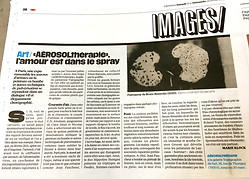AEROSOLTHERAPIE
Topographie de l'art
Paris
04. 12. 20 - 20. 03. 21
Commissaire
C.N. Jelodanti (Clara Djian & Nicolas Leto)
Artistes
-
Christian Aubrun
-
Bruno Bressolin
-
Larry Deyab
-
Frédéric Fleury
-
Orsten Groom
-
Jean Faucheur
-
Hippolyte Hentgen
-
C.N Jelodanti
-
Rainier Lericolais
-
Renée Levi
-
Jules Olitski
-
Jim Sanders
-
Shoboshobo
-
Sindre Foss Skancke
-
Roland Topor
Interview & article in Libération
(click to read)
The exhibition "AEROSOLTHERAPY" presents various plastic works by fifteen painters or draftsmen all using or having used aerosol - Jules Olitski, Roland Topor and Larry Deyab, of the party, died in 2004, 1997 and 2016 respectively. This use is of a diverse, protean nature.
Some artists use spray paint exclusively, either to trace or to cover the canvas or the support of the drawing. Others, more parsimonious or more adventurous, use it in addition to more conventional ways of painting or drawing. Spraying, the act of vaporizing, enriches their palette, composition and stylistic effect.
Aerosol therapy, the care technique that gives the exhibition its title, consists of having a patient inhale, by nebulization, medicines suspended in a gas, in order to convey a micro-mist (aerosol in the strict sense) of curative substances into his or her respiratory tract.
In relation to artistic expression, the aerosol-therapeutic principle is intended to suggest that aerosol painting, Spray Painting, is not without effect on the very state of representation, both pictorial and graphic. Light by its material but dense by its effects, it can act as an inventive revival, as a reinforcement, as a beneficial prop.
Its power to energize pictorial art or drawing makes it an essential ally, fraternal, helpful when needed, of the plastic creation.
Paul Ardenne

DYM - THE ORIGIN OF ART / 220 x 270cm
A SMOKE
Orsten Groom
My friend the writer Pierre Pachet died in 2016.
A commemorative name plaque was placed at his homeplace.
Pierre was a Jew - but you still had to know him to find out, for the name ain’t obvious.
The plaque does not mention this fact, which did not preserve it from being smeared shortly afterwards
by an anti-Semitic folk graffiti.
Anger and stupefaction - but even more stunning:
my unfathomable stupidity at the discovery of this information.
Indeed, the newspaper spelled out: "A swastika discovered under Pierre Pachet's plaque"
- and I, amazed, reasoned: "What do you mean 'under' ?
They removed the plate to draw a swastika underneath, then put it back on? Unbelievable!"
That's how dumb a painter is.
Of course everyone understands that it meant « below », but not me.
So there goes the following chain of thoughts:
"Anti-Semitic acts / marks are so commonplace, constant & daily since the dawn of time, it’s not surprising that they are to be found under everything: they are such a constant of humanity that you would probably find some underneath the rock paintings of Lascaux and Chauvet if you scratch them - it has to be".
This idea suddenly made me burst with laughter.
Only art provides a way out - only art can take the affliction of reality in charge, so as to rave it,
to "leap out of the ranks of assassins" (Kafka).
Only painting could experience such a cognitive (stupid) flaw according to its own reasoning,
and regulate this Witz, this trait of mind that brings down the parietal paintings to primary idiopathic graffitis
- i.e. play them together.
For art never produces any victims: in art one can massacre, play the 3rd World War, make Jacqueline cry - otherwise you become a fanatic of reality, an ideologue.
In art, all values neutralize and judge each other by interposed intimacy, against the tyranny of reality and the catastrophe of human time.
Thus, anti-Semitic graffiti as the background of time, as a prerequisite of art, of the relationship to the world - the parietal and the historical filth, the cultural debility - I have deliver them to the canvas.
But not alone: this ignoble, disgusting gesture, so foreign to me that it threatens my very identity,
I had to delegate it, so as to offer it plainly to the interface of painting.
So I called a few anti-Semitic friends - Poles like me - and hand over the bomb to them.
This was done according to two principles. First, the observation that most swastikas are always messed up, drawn crookedly or upside down, comically too complicated for the morons who draw them
(and thus miss them).
The second follows a Polish slang expression rooted in the Shoah:
Szukasz Dym?
Are you looking for trouble?
Literally: looking for smoke.
It is this smoke that this painting calls for.
This smoke of confusion, of ambivalence, also the under the fire at the origin of art
- so as to take in the horror of the world it shields against.
A hilarious smoke, as light and solemn as only art can be.
- a smoke for Pierre Pachet.









